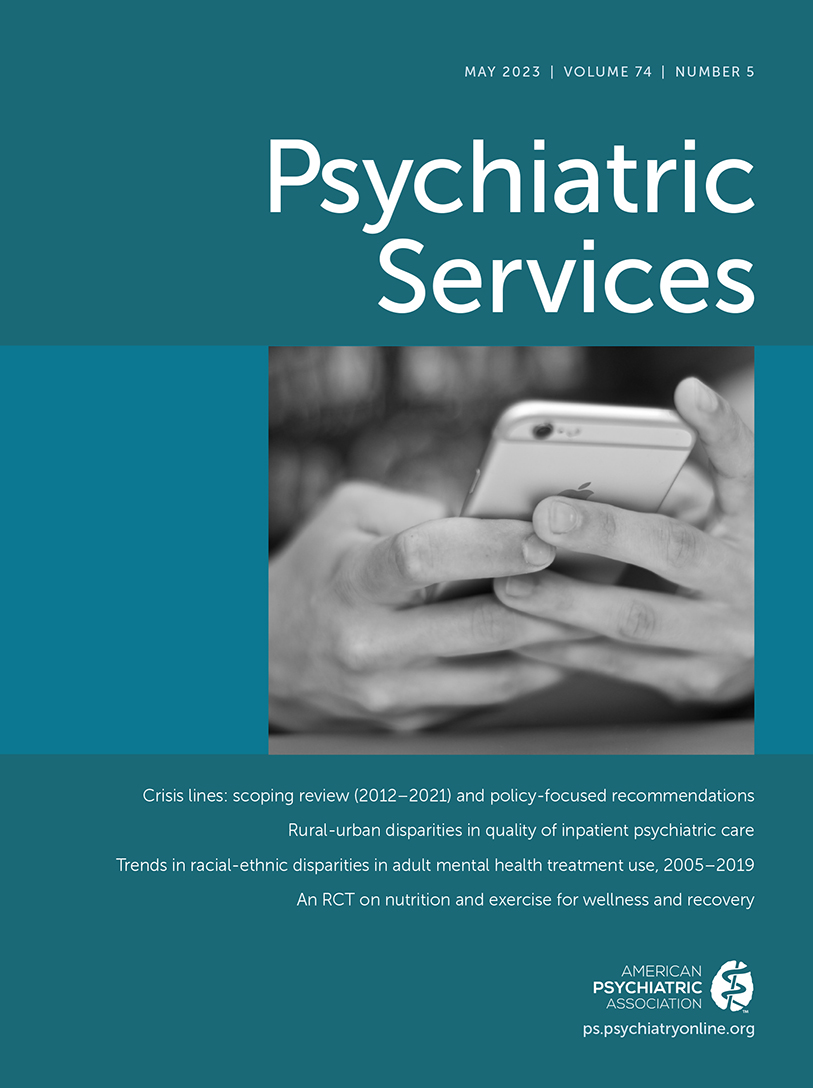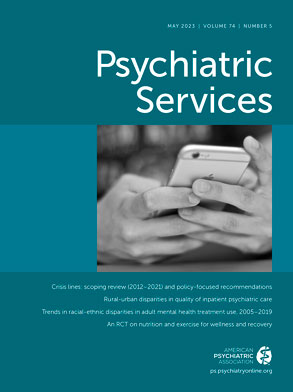Similar to other mental health providers, certified peer specialists (CPSs)—people with lived experience of psychiatric or substance use disorders trained to provide recovery support services—transitioned to utilizing telehealth during the COVID-19 pandemic (
1). Peer support services are offered in group or one-on-one sessions in a variety of settings and commonly involve health-and-wellness activities, sharing of recovery stories, crisis support, and connection of peers to community resources (
2,
3). These services, which can be provided through different modalities, have been a beneficial and accessible resource during the COVID-19 pandemic (
4). However, little is known about the experiences of CPSs during the pandemic, the challenges they have faced, and the supports that have facilitated their work.
Several factors enable CPSs to be successful in their jobs, including a supportive organizational culture, integration into mental health teams, clarity in roles and responsibilities, delivery of services without micromanagement, and supervisor support of career development (
5,
6). However, CPSs face challenges in their workplaces, such as limited compensation and benefits, ineffective supervision, internalized stigma from coworkers, difficulties when other staff do not understand the CPS’s role, and maintenance of their own mental health (
5,
7–
9). Many workplaces have hierarchical structures that may place CPSs in positions of lesser power and agency compared with other providers (
7). Therefore, it is important to understand how organizational factors support or hinder CPSs as they implement telehealth services.
The purpose of this study was to gain an in-depth understanding of the experiences of CPSs in transitioning to telehealth services during 2020 as a result of the COVID-19 pandemic. We examined the barriers and facilitators that CPSs have experienced in delivering telehealth services, factors at the organizational level that have supported or hindered CPSs in delivering telehealth services, and how employers can support CPSs in using telehealth in the future.
Methods
The research team included public health researchers, graduate students, and CPSs with lived experience who are leaders of a peer-run organization. We use the term “peer,” rather than “patient,” to refer to people with psychiatric conditions who receive services from a CPS because the term acknowledges the collaborative and nonhierarchical relationship between peers and CPSs. Study procedures were approved by the Emory University Institutional Review Board. (Additional details on the methods used are available in the online supplement to this report.)
Participants were employed as CPSs in Georgia, were ages ≥18 years, spoke fluent English, and had access to a device with audio and video capability. Participants were recruited through an announcement and flyer that were sent by e-mail to CPSs on the Southeast Mental Health Technology Transfer Center (MHTTC) and Georgia Mental Health Consumer Network contact lists and posted to the Southeast MHTTC’s website and social media platforms. Interested individuals contacted a researcher, who shared a link to an online Qualtrics form that included screening questions, an informed-consent form for eligible individuals, and demographic questions for individuals who consented to participate. A researcher followed up with potential participants to schedule an interview. From August to November 2020, a total of 32 people completed the online screening and consent form, 18 people were contacted to schedule an interview, and 14 people completed interviews via Zoom. Interviewers used a semistructured interview guide that focused on CPSs’ experiences with providing telehealth services. Participants received a $50 gift card.
Interviews were audio recorded with Zoom, transcribed verbatim, deidentified, and uploaded to the qualitative software MAXQDA 2020 for analysis. Data analysis was guided by thematic analysis, a flexible method for identifying patterns in qualitative data (
10), and by the social ecological model (
11). The team developed a codebook, and all transcripts were double-coded and reviewed for consistency across coders. Key themes were described through an iterative process of memo writing and team discussion, with a focus on examining factors at the peer, CPS, and organizational levels.
Results
The sample included 14 CPSs (demographic information is available in the online supplement). Before the COVID-19 pandemic, the participants’ limited telehealth experience included outreach and communication about appointments and scheduling by telephone.
At the onset of the pandemic, the CPSs’ workplaces closed, and service delivery shifted to telephone or videoconferencing. CPSs expressed that prompt, clear, and responsive communication from their employer helped them feel safe. One CPS shared that their organization “knew this was stressful for everyone, and we didn’t have a plan, so they kept the lines of communication open.” CPSs appreciated when employers provided training or resources on information related to COVID-19 and telehealth service delivery. Some CPSs felt dissatisfied when their organizations or supervisors did not communicate transparently about ongoing changes and did not provide training. When working from home, most CPSs used their personal devices (i.e., smartphones and computers) to deliver services, although a few employers provided equipment. CPSs adapted their typical services to telehealth delivery, with an additional focus on providing information related to COVID-19 and coping with stress.
At the time of the interviews, some CPSs were transitioning back to in-person shifts. Although some CPSs were “happy to get back to our normal schedule,” others expressed feeling pressure from their employers to return to in-person services. One CPS noted, “I began to feel some of the pressures of getting back into the community before I was quite ready. . . . But it’s been [sighs] not overtly implied, but more tacitly implied, that we need to get out in the community.” CPSs who met peers in person used several strategies to maintain their safety, including meeting in outdoor spaces and practicing social distancing in the clinic.
Of note, more than one-third of our sample shared that they experienced mental health challenges in response to COVID-19 and their work. These CPSs described elevated psychiatric symptoms and a continuation of or return to mental health treatment. For CPSs, figuring out how to maintain self-care in order to continue their work was important.
Key themes related to barriers to and facilitators of delivering telehealth services were related to interpersonal relationships and logistical factors (
Table 1). Many CPSs felt that telehealth delivery resulted in lower-quality interactions and less personal connection with peers compared with in-person services. Telehealth services were particularly challenging when working with peers who were in crisis and peers with whom the CPS did not have an established relationship. As one CPS described, “When you’re not face to face with somebody, you can’t read their energy. . . . And it’s really hard to . . . form that connection with peers, especially peers who are just entering the program.” However, several CPSs also said that telehealth was “definitely better than nothing.” Increased use of telehealth enabled CPSs to maintain regular communication with peers, engage peers who felt more comfortable participating from home, and easily contact peers who experienced transportation barriers.
CPSs and peers experienced challenges with technology, including variable access to equipment (e.g., smartphone, computer) and a high-quality Internet connection, insufficient reception and data for smartphone plans, and low familiarity with the technology. As one CPS noted, “A lot of [the tools] we use are kind of odd over the telephone. We use a lot of games to interact with [peers], and it’s hard to do a game to interact on the telephone.” Some CPSs described working together to learn strategies and find resources for telehealth delivery. A few CPSs felt frustrated with clinic policies (e.g., not using videoconferencing) that limited their flexibility to use different modalities to offer services.
Most CPSs expected the use of telehealth to continue in the future, specifically in combination with in-person services and for maintaining contact with peers who experience challenges with transportation, live far away from a clinic, or could benefit from regular informal contact. CPSs offered several suggestions for how to support and improve their ability to provide telehealth services. First, CPSs said that provision of training in telehealth technologies is important. Second, they recommended that employers provide equipment with adequate data plans rather than require their employees to use personal devices. Third, they preferred flexibility in how they deliver their services, whether by videoconferencing, telephone, in person, or a combination of methods.
Discussion
To our knowledge, this study is the first to describe CPSs’ experiences with telehealth during the COVID-19 pandemic. Our findings add CPSs’ perspectives to the growing literature on providers’ experiences with telehealth during the pandemic and point to ways employers can support CPSs in implementing telehealth. Overall, CPSs felt that the quality of telehealth service delivery was not as strong as that of in-person services. However, they agreed that telehealth allowed for connection with peers during a difficult time and provided the ability to reach peers who experience access barriers. The foundational elements of the CPS role—storytelling, empathy, active listening, goal setting, and recovery—remained important when connecting with peers during the pandemic (
12).
Several organizational factors were central to supporting CPSs in delivering telehealth services and offer several lessons for future integration of telehealth into peer support under less restrictive circumstances. CPSs described the importance of leadership communicating clearly and openly, providing support, valuing CPSs and their mental health, offering training on videoconferencing platforms, providing telecommunication devices and adequate data plans, and allowing flexibility and choice in delivery method. Participants reported that telehealth may work better for peers with a preexisting relationship with a CPS or who experience transportation challenges. Conversely, in-person services may be preferable for peers receiving services for the first time and peers who are in crisis. These findings align with other research showing that organizational support and choice in delivery methods are important factors in implementing recovery-oriented services (
12,
13). The CPSs who had transitioned back to providing limited in-person peer support services expressed a range of reactions, from being excited to return to their workplaces to feeling pressured to reengage in the community. It is important for supervisors to acknowledge power dynamics that may exist between themselves and CPSs (
7) and to thoughtfully engage CPSs in discussions of workplace transitions. In addition, although most CPSs maintain their psychiatric health (
14), situations of high stress such as the COVID-19 pandemic can contribute to greater mental health challenges (
1). Therefore, it is important for organizations to ensure access to resources that support CPSs’ well-being.
This study had several limitations to consider. Although our sample included CPSs who worked in various settings, participants all worked in one state and were recruited through two organizations. Therefore, CPSs working in other states or those not connected with organizations that provide training and support for CPSs may have additional experiences and perspectives that were not included in this study. Although the number of interviews and the review of the transcripts and notes indicated that we reached coding saturation, thus identifying salient topics within the data (
15), the data were insufficient for detailed comparisons across employment settings. Finally, this study did not include the perspectives of peers who received services from CPSs, and future research would benefit from engaging both peers and CPSs.
Conclusions
Our findings suggest several ways employers can facilitate continued implementation of telehealth by CPSs through the COVID-19 pandemic and beyond. Employers can support CPSs by providing training and equipment, engaging CPSs in open and transparent communication, and allowing CPSs the flexibility to tailor service delivery modalities to the peers they serve.
Acknowledgments
The authors acknowledge and are grateful for the contributions of Max Spiewak, M.P.H., to the data collection. These views represent the opinions of the authors and not necessarily those of the U.S. Department of Health and Human Services or SAMHSA.

